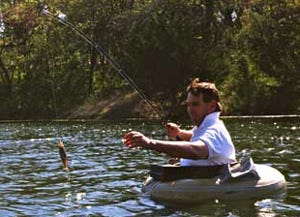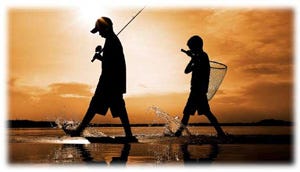New system alleviates fishery problems
Several partner organizations including Tulsans teamed on a project recently to help alleviate chronic water shortages and water quality problems in the Lower Illinois River trout fishery below Lake Tenkiller dam.
The Oklahoma Department of Wildlife Conservation with the U.S. Army Corps of Engineers and Southwestern Power Administration, and sport groups the Indian Nations Chapter of Trout Unlimited and Tulsa Fly Fishers placed a new system to provide water and oxygenation to the river during periods of low flow and a system to monitor downstream water quality. Currently, none of Lake Tenkiller's water is allocated for managing the popular fishery. Instead, the Wildlife Department has relied on a limited supply of water made available by other water storage rights holders, such as Sequoyah Fuels, and then only during sporadic water releases. Leakage in the dam had provided some water flow until recently repaired. The Wildlife Department was left with access to just two hours of water flow or less per day to manage 7.75 miles of trout fishery. The inability to secure adequate water flow from the dam has caused low dissolved oxygen levels, toxic algae blooms and significant fish kills. Studies indicate the fishery has an economic impact of up to $5 million per year on local business. The new system, unveiled at a ceremony held among partners at the site of the project, includes a low-flow pipeline that the Wildlife Department can use to deliver borrowed water to the river even when the dam isn't generating water flow.

The Lower Illinois River below Lake Tenkiller is one of only two year-round trout fisheries in Oklahoma and is a popular destination for sportsmen.
"This pipeline allows us to make more efficient use of available water," said Barry Bolton, chief of fisheries for the Wildlife Department. "Prior to construction of the pipeline, we were unable to control the volume of water released. With the ability to more closely monitor water releases, we can more effectively manage water quality downstream."
Additionally, a dissolved oxygen enhancement system has been provided to increase oxygen in the water immediately below the dam. Paired with the water provided by the new pipeline, this system can help prevent the conditions that have resulted in fish kills in the past. Monitoring stations set up at 13 downstream locations can help managers track water conditions as well.

"The system we've put in place will conserve water and improve dissolved oxygen levels, meaning better management, effective prevention of fish kills and improved fishing for anglers," Bolton said. Though the new system will help address the issues facing the fishery, Bolton said adding a long-term solution is still needed, which must include a dependable source of water to maintain the fishery down the stream.

Established in 1965 as mitigation for the construction of Tenkiller Dam, the Illinois River trout fishery has become a recreational and economic staple for the region. Finding solutions to water shortages in the river poses unique challenges, but Bolton said the Wildlife Department is committed to the survival of the fishery.



